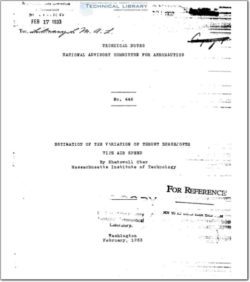naca-tn-446

- Version
- 115 Downloads
- 659.12 KB File Size
- 1 File Count
- April 23, 2016 Create Date
- April 23, 2016 Last Updated
National Advisory Committee for Aeronautics, Technical Notes - Estimation of the Variation of Thrust Horsepower with Air Speed

The purpose of this note is to present a method of
estimating the variation of thrust horsepower with air
speed, when the power unit consists of a conventional,
thin, metal, fiXed—pitch propeller driven by an internal~
combustion engine. Such a curve is needed for the esti—
mation of airplane performance in conjunction with aspects
of horsepower required for maintaining level flight. The
method is intended to be used in conjunction with data on
families of propellers tested with airplane and engine
given in the form of selection charts of V/nD and pro—
pulsive efficiency plotted against. Gs, the speed power
coefficient. Complete familiarity with the use of such
charts (reference 1) is presupposed, as well as an under—
standing of the adaptation of them to the determination of
approximate characteristics of other propellers (reference
2, Ch. XVII); so this note may be considered an addition
to those references. As far as possible standard symbols
are used and will not be defined.
The nature of the problem is this. With a definite
propeller whose characteristics are known or can be esti—
mated, and which has been selected to fit an airplane
having a certain engine and a certain maximum speed, the
thrust horsepower is knOWn for one air speed. With a
change in air speed due to a modification of the attitude
of the airplane without a change in the throttle setting
there will usually_be a change in revolution speed. The
brake horsepower of the engine at constant throttle is a
direct function of the revolution speed. Since the pro—
pulsive efficiency depends only on the ratio of the air
speed to the revolution speed, both the brake horsepower
and the propulsive efficiency can be found if the varia—
tion of the revolution speed with the air speed is known as
The thrust horsepower is then the Product of the brake
horsepower and the propulsive efficiency.
| File | Action |
|---|---|
| naca-tn-446 Estimation of the Variation of Thrust Horsepower with Air Speed.pdf | Download |

Comment On This Post